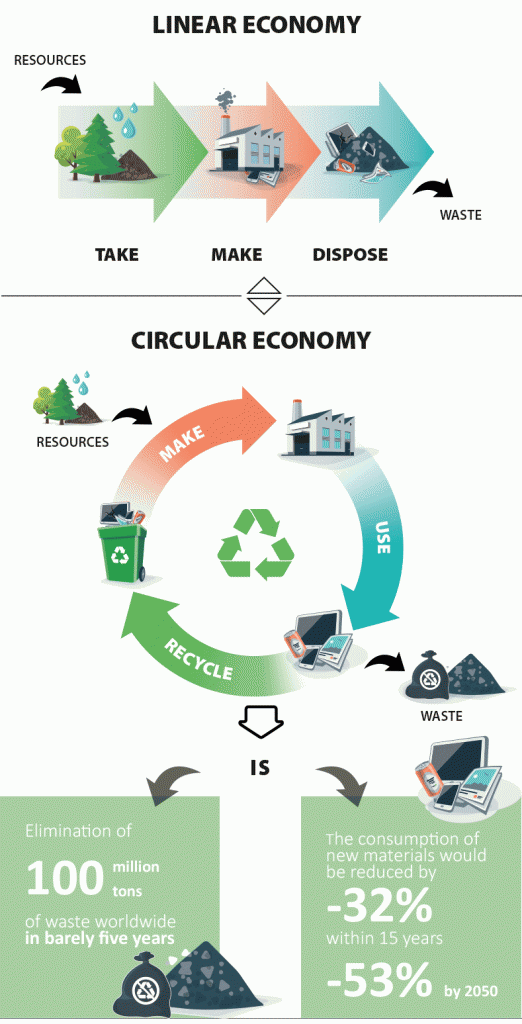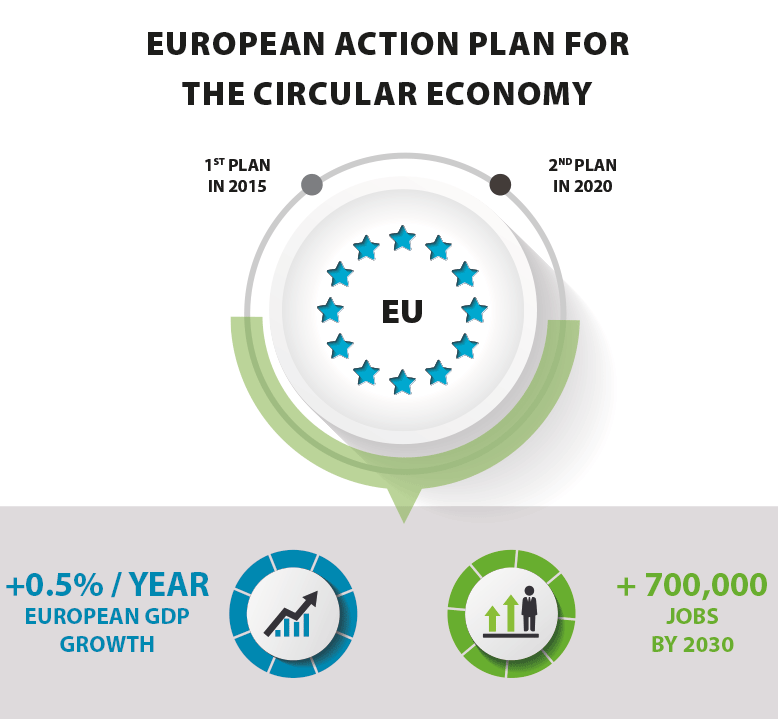Economic shifts
The circular economy, a choice for society and business

Since the 18th century and the dawn of the industrial age, technical progress has been based on the unlimited use of natural resources. However, this era could well be coming to an end. The climate crisis has led to a growing consensus on the need to change our attitude to economic development. Representing a new approach to the way that goods are designed, produced and consumed, the circular economy is increasingly being seen as a genuine alternative.
 Nature does not produce any waste, everything is reused. All of its resources are preserved for the long term. Inspired by this example, the circular economy seeks to make a clean break with the so-called linear economy, based on the traditional ‘take-make-consume-throw away’ model. Rémy Le Moigne, the CEO of circular economy consultancy Gate C, sums up the aim of this model for production and consumption as “sharing, reusing, repairing and recycling existing products and materials, so that they retain their value to the economy for as long as possible.” Faced with the climate emergency and the world’s growing population, which is leading to an ever greater exploitation of the Earth’s resources, changing our approach to the economy is certainly an attractive prospect. In 2014, experts showed that switching to a circular economy would lead to the elimination of 100 million tons of waste worldwide in barely five years1. Meanwhile, the consumption of new materials would be reduced by 32% within 15 years, and by 53% by 20502.
Nature does not produce any waste, everything is reused. All of its resources are preserved for the long term. Inspired by this example, the circular economy seeks to make a clean break with the so-called linear economy, based on the traditional ‘take-make-consume-throw away’ model. Rémy Le Moigne, the CEO of circular economy consultancy Gate C, sums up the aim of this model for production and consumption as “sharing, reusing, repairing and recycling existing products and materials, so that they retain their value to the economy for as long as possible.” Faced with the climate emergency and the world’s growing population, which is leading to an ever greater exploitation of the Earth’s resources, changing our approach to the economy is certainly an attractive prospect. In 2014, experts showed that switching to a circular economy would lead to the elimination of 100 million tons of waste worldwide in barely five years1. Meanwhile, the consumption of new materials would be reduced by 32% within 15 years, and by 53% by 20502.
Companies support a change of business model
From major corporations to small firms, many businesses have realized that they need to be a part of this transformation. In 2017, 33 companies from different sectors of the French economy, all members of the national association of private firms (AFEP), made a series of commitments to support the circular economy. Fnac, one of France’s major electronics retailers, created a new logo that indicated the environmental impact of its TV sets, tablets, PCs and smartphones, while L’Oréal announced that it would stop manufacturing products that contain PVC. The Michelin Group extended the usable life of its tires, as a way of combating built-in obsolescence. By only recommending a tire change after 1.6mm of wear, the company was able to avoid the use of 100 million tires a year, thereby reducing CO2 emissions by 6.6 million tons in Europe3.
Separately, there are now countless start-ups investing in innovative solutions. The move toward a sharing economy, in particular, is growing in momentum every year. Business models in France can involve the sharing of goods, with Mutum, or services, such as Sharevoisin, or even skills, with Les Talents d’Alphonse. Such offerings might be commercial ventures (AlloVoisins, for example, pays both the users and the platform) or they could be free to use (Mutum does not reward either lenders or the platform).
Lawmakers in France and at the European Union level are also supportive of change, with the EU adopting an initial action plan for the circular economy in 20154, followed by a second one in 2020. Such plans have highlighted the expected economic benefits – with a 0.5% increase in GDP across the EU every year and the creation of 700,000 jobs by 20305. In France, a 2015 law on the energy transition for green growth (LTECV), along with legislation in 2020 against waste and in favor of the circular economy, have provided a series of measures to encourage best practice.
For François-Michel Lambert, head of France’s National Institute for the Circular Economy and a lawmaker for the 10th district of the Bouches du Rhône region: “It’s essential to have a legislative impetus, because companies only make progress when it’s a question of politics. Unfortunately, the debate today is too often limited to the sole issue of recycling, when actually the real issue is efficiency.”
Economic benefits, standardization and usage
While legislation and the actions of some companies have led to some major advances, progress is still insufficient compared to the scale of the challenge. While specialists discuss the best strategy to adopt, there is at least one point on which everyone agrees: the biggest obstacle is a cultural one. A profound change is needed, notably among the leading industrial players: the construction industry in France produces 230 million tons of waste every year – five times the amount of household waste6. “The approach that works best is to show (them) the business benefits of a circular economy,” underlines Rémy Le Moigne. “A purchasing director needs to know that adopting circular strategies will reduce their costs, while also shrinking their company’s environmental footprint.” As a specialist in the field, he believes that the Covid-19 crisis could help to raise awareness of the issue. “In some countries, hospital authorities said they were going to restore their old respirators, and they have achieved fantastic results. The circular economy has shown that it’s a very resilient economy – and sometimes a more efficient one.”
Along with gaining the support of companies and lawmakers, however, there is also a need to clarify standards for the circular economy. “One of the main reasons why so little recycled plastic gets used is because it’s hard to assess its quality,” explains Rémy Le Moigne.
By the same token, while there is a major market for office furniture that has been restored to ‘as-new’ condition, it’s still only a fledging one in France. The reason is yet again a lack of standards — guaranteeing that a strict process of quality control has been applied. To standardize the circular economy, privately-run eco-label schemes, such as Longtime (which covers the durability of consumer goods) will have an important role to play. “These labels create a visible difference, which highlight the added value,” comments François-Michel Lambert. “In today’s business world, they enable companies to achieve the margins they need to cover the cost of using the right products, carrying out the best practices, etc.”
He is among those who want to go even further and who are calling for a transition to “an economy of functionality.” “It’s essential to switch from purchasing to usage. To no longer own products, but to pay to use them, which means making better use of the same resources.” There too, civil society’s awareness and willingness to change will be vital, particularly when it comes to further encouraging entrepreneurs to develop innovative solutions for the world of tomorrow.

